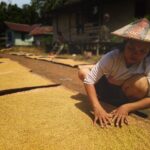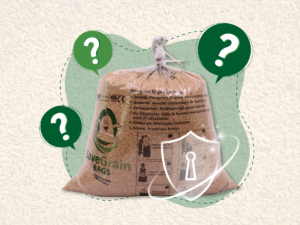Food security is a growing concern the world over. To ensure that, it is important to not only increase agricultural production but also find ways to decrease the post-harvest losses occurring during storage or distribution.
Mold growth is one of the major causes of food loss. Mold can spoil the grain by lowering its nutritional value and quantity. Besides, mold growth can cause the release of aflatoxins. Aflatoxins are toxic substances that pose serious health risks on consumption, by either humans or livestock.
Mold growth can occur as a result of two types of fungal pathogens: field fungi and storage fungi. While field fungi require higher moisture content, infecting the grain only in the field, storage fungi develop under certain storage conditions.

What are the risk factors for mold?
The main risk factor for fungi to develop is grain moisture content: at the time of harvest and during storage. Fungal pathogens require a minimum amount of moisture in order to germinate and invade the grain.
In addition to that, the other factors that increase the risk of mold growth are:
- Presence of inoculum on the grain before storage.
- Impurities in the grain such as weed, seed, insects, broken seed, plant debris.
- Storage temperature; at higher temperatures, fungal pathogens become more active.
- Length of the storage period.
There’s not much that can be done to prevent growth of field fungi, but the growth of storage fungi can definitely be prevented, to preserve the harvest in its optimal form.

Tips to prevent mold growth during grain storage
Proper storage measures can go a long way in decreasing food loss due to mold growth. Here are some ways to achieve this:
- Harvest the grain at the correct moisture content. Use equipment such that there’s minimal damage to the grain kernels, since mold growth tends to be higher in damaged kernels.
- Monitor pre-harvest and post-harvest grain moisture content. Wet or damp grains are breeding grounds for molds and pests.
- Grain should be carefully cleaned before storing it, to make sure that it is completely free of broken seed, plant debris, insects, weed, or any foreign material.
- Similarly, ensure that the storage bins and bags are equally clean. Hence, a disinfectant is important to use
- Dry and store grains at their respective appropriate moisture contents. This is usually below 15 per cent moisture levels, in order to minimize contamination by mold and mycotoxins.
- Keep external moisture away from the storage area. This means the stored grain should be protected from rain, floods, and other climatic changes.
- Store dried grain at cooler temperatures (36-44 °F). Monitor temperature during storage. Keep it stored in shade, away from direct sunlight.
- Periodically check the stored grain for mold and insects.
- Aerate grain periodically and equalize temperature throughout the grain mass in the storage unit. This helps to avoid hot spots conducive to fungal growth. Moreover, aeration will also push musty odors to the surface, which are indicative of mold growth.
- Monitor grain crusting, that is symptomatic of growing fungi.
- If mold is found, send a grain sample to identify and analyze it, and to check for the presence of toxins.
- Lastly, use air-tight and moisture-tight storage units, that protect the grain from moisture changes, insect contamination, and mold growth.
Hermetic technology prevents the exchange of moisture and protects the grain from infestation and mold growth.
Save Grain Bags offers these hermetic storage bags, which allow grain storage in its ideal condition. This way, the lack of moisture and mold results in no impact on the grains. This helps to reduce post-harvest food losses, taking us closer to attaining food security.





